
Sierra Nevada subalpine zone
Encyclopedia
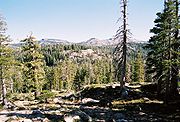
Life zone
The Life Zone concept was developed by C. Hart Merriam in 1889 as a means of describing areas with similar plant and animal communities. Merriam observed that the changes in these communities with an increase in latitude at a constant elevation are similar to the changes seen with an increase in...
below treeline in the Sierra Nevada mountain range
Mountain range
A mountain range is a single, large mass consisting of a succession of mountains or narrowly spaced mountain ridges, with or without peaks, closely related in position, direction, formation, and age; a component part of a mountain system or of a mountain chain...
of California
California
California is a state located on the West Coast of the United States. It is by far the most populous U.S. state, and the third-largest by land area...
, United States
United States
The United States of America is a federal constitutional republic comprising fifty states and a federal district...
. This subalpine zone is positioned between the upper montane zone (such as red fir forest) at its lower limit, and tree line at its upper limit.
The Sierra Nevada subalpine zone occurs between 2450–3660 m (8,038.1–12,007.9 ft), and is characterized by an open woodland of several conifer species, including whitebark pine
Whitebark Pine
Pinus albicaulis, known commonly as Whitebark Pine, Pitch Pine, Scrub Pine, and Creeping Pine occurs in the mountains of the Western United States and Canada, specifically the subalpine areas of the Sierra Nevada, the Cascade Range, the Pacific Coast Ranges, and the northern Rocky Mountains –...
, lodgepole pine
Lodgepole Pine
Lodgepole Pine, Pinus contorta, also known as Shore Pine, is a common tree in western North America. Like all pines, it is evergreen.-Subspecies:...
, western white pine
Western White Pine
Western White Pine, Pinus monticola in the family Pinaceae, is a species of pine that occurs in the mountains of the western United States and Canada, specifically the Sierra Nevada, the Cascade Range, the Coast Range, and the northern Rocky Mountains. The tree extends down to sea level in many...
, mountain hemlock
Mountain Hemlock
Tsuga mertensiana, known as Mountain Hemlock, is a species of hemlock native to the west coast of North America, with its northwestern limit on the Kenai Peninsula, Alaska, and its southeastern limit in northern Tulare County, California....
, and Sierra juniper. The vegetation and ecology is determined by the harsh climate, with extensive snow and wind. In addition, soils are thin and nutrient-poor. Due to these harsh conditions, vegetation grows slowly and at low temperatures. In addition, the stressful environment suppress species competition and promotes mutualism.
The marginal conditions make the Sierra Nevada subalpine zone sensitive to environmental changes, such as climate change
Climate change
Climate change is a significant and lasting change in the statistical distribution of weather patterns over periods ranging from decades to millions of years. It may be a change in average weather conditions or the distribution of events around that average...
and pollution
Pollution
Pollution is the introduction of contaminants into a natural environment that causes instability, disorder, harm or discomfort to the ecosystem i.e. physical systems or living organisms. Pollution can take the form of chemical substances or energy, such as noise, heat or light...
. The long-lived nature of the subalpine species make the zone a good study system to examine these effects.
Location
The subalpine zone of the Sierra Nevada occurs between 2900–3660 m (9,514.4–12,007.9 ft) in the southern part of the range and 2450–3100 m (8,038.1–10,170.6 ft) in the north. Because the Sierra is higher in the south, the majority of subalpine occurs in the central and southern portions of the range, south of the Lake TahoeLake Tahoe
Lake Tahoe is a large freshwater lake in the Sierra Nevada of the United States. At a surface elevation of , it is located along the border between California and Nevada, west of Carson City. Lake Tahoe is the largest alpine lake in North America. Its depth is , making it the USA's second-deepest...
basin. A few isolated patches occur in the north on mountain peaks higher than 2400 metres (7,874 ft).
Climate and physical factors
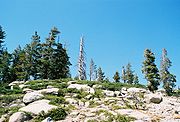
Winds can be high throughout the year and are a major factor limiting plant growth near the upper limit of the subalpine zone (tree line). Wind limits vegetative growth chiefly in two ways: by physically battering plants, including blowing snow and ice, and by increasing evapotranspiration
Evapotranspiration
Evapotranspiration is a term used to describe the sum of evaporation and plant transpiration from the Earth's land surface to atmosphere. Evaporation accounts for the movement of water to the air from sources such as the soil, canopy interception, and waterbodies...
in an environment that is already water-stressed.
Soils are thin, coarse and relatively nutrient-poor, owing to the unproductive climate and repeated glaciation events during the Pleistocene
Pleistocene
The Pleistocene is the epoch from 2,588,000 to 11,700 years BP that spans the world's recent period of repeated glaciations. The name pleistocene is derived from the Greek and ....
. Moisture retention is usually high, due to the presence of underlying granite bedrock, and soils often become waterlogged early in the growing season. However, because very little precipitation falls during the summer months, soils can dry quickly once snow melts and vegetative growth and reproduction is limited late in the growing season by drought.
Compared to subalpine zones in the Cascade Range
Cascade Range
The Cascade Range is a major mountain range of western North America, extending from southern British Columbia through Washington and Oregon to Northern California. It includes both non-volcanic mountains, such as the North Cascades, and the notable volcanoes known as the High Cascades...
, Sierran subalpine experiences less annual precipitation, with a longer drought period during the summer months, but similar temperature ranges throughout the year. Compared to Rocky Mountain subalpine zone, Sierran subalpine experiences a narrower (more mild) range of temperatures and higher annual precipitation, with more winter snow and less summer rain.
Physiognomy
Generally, Sierran subalpine is dominated by woodland, which means the canopy cover averages between 30-60 % closure (>60 % closure is considered forest). However, some species, particularly in protected sites with deeper soils and reduced wind, form closed-canopy stands. Growth form of trees is also variable; single-stemmed, large individuals are more abundant at lower elevations and protected sites, while multi-stemmed, stunted (krummholzKrummholz
Krummholz or Krumholtz formation — also called Knieholz — is a particular feature of subarctic and subalpine tree line landscapes. Continual exposure to fierce, freezing winds causes vegetation to become stunted and deformed...
-form) individuals are more abundant near tree line.. Herb and shrub-dominated communities also occur, but comprise a small proportion of the total land area within the subalpine
Subalpine
The subalpine zone is the biotic zone immediately below tree line around the world. Species that occur in this zone depend on the location of the zone on the Earth, for example, Snow Gum in Australia, or Subalpine Larch, Mountain Hemlock and Subalpine Fir in western North America.Trees in the...
zone. Meadows can occur where water is more available.
Composition
Shrubs and herbs are usually sparse, but can be common in stands where snow melts earlier in the growing season. Diversity of herbs in the subalpine zone is usually less than lower-elevation zones such as upper and lower montane. Broad classifications of herb and shrub communities can be found in Sawyer and Keeler-Wolf. For a fine-scale classification of subalpine meadow communities, see Benedict.The composition of tree species within Sierran subalpine is variable with comparatively high diversity for subalpine. Rocky Mountain subalpine stands, for example, are usually dominated by a single tree species. Stands in the Sierra may be mixed, with up to five species present, or pure, monospecific stands, depending on the range of the species and microsite
Microsite (ecology)
A microsite is a term used in ecology to describe a pocket within an environment with unique features, conditions or characteristics. Classifying different microsites may depend on temperature, humidity, sunlight, nutrient availability, soil physical characterictics, vegetation cover, etc....
conditions.
Whitebark pine
Whitebark Pine
Pinus albicaulis, known commonly as Whitebark Pine, Pitch Pine, Scrub Pine, and Creeping Pine occurs in the mountains of the Western United States and Canada, specifically the subalpine areas of the Sierra Nevada, the Cascade Range, the Pacific Coast Ranges, and the northern Rocky Mountains –...
(Pinus albicauls) is possibly the most widespread component of subalpine woodland in the central and northern regions of the Sierra. This species is found at higher elevations than all other species in this region, forming dense monospecific stands of krummholz near the tree line and near ridgetops. At lower elevations, whitebark pine can co-occur with lodgepole pine
Lodgepole Pine
Lodgepole Pine, Pinus contorta, also known as Shore Pine, is a common tree in western North America. Like all pines, it is evergreen.-Subspecies:...
, Sierra juniper (Juniperus occidentalis ssp. australis) and mountain hemlock
Mountain Hemlock
Tsuga mertensiana, known as Mountain Hemlock, is a species of hemlock native to the west coast of North America, with its northwestern limit on the Kenai Peninsula, Alaska, and its southeastern limit in northern Tulare County, California....
(Tsuga mertensiana).
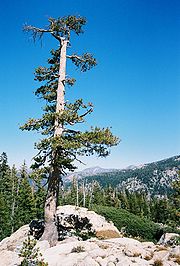
Lodgepole Pine
Lodgepole Pine, Pinus contorta, also known as Shore Pine, is a common tree in western North America. Like all pines, it is evergreen.-Subspecies:...
(Pinus contorta ssp. murrayana), which occurs in vast stands in the upper montane zone, is found mostly in mixed stands in subalpine woodland, particularly with whitebark pine. Lodgepole is not usually found near tree line, although it does occasionally form krummholz.
Western white pine
Western White Pine
Western White Pine, Pinus monticola in the family Pinaceae, is a species of pine that occurs in the mountains of the western United States and Canada, specifically the Sierra Nevada, the Cascade Range, the Coast Range, and the northern Rocky Mountains. The tree extends down to sea level in many...
(Pinus monticola) can be found in pure stands, especially on exposed slopes, where snowpack is shorter-lived. More commonly however, western white pine grows in mixed stands with lodgepole, mountain hemlock
Mountain Hemlock
Tsuga mertensiana, known as Mountain Hemlock, is a species of hemlock native to the west coast of North America, with its northwestern limit on the Kenai Peninsula, Alaska, and its southeastern limit in northern Tulare County, California....
, Jeffrey pine
Jeffrey Pine
The Jeffrey Pine, Pinus jeffreyi, named in honor of its botanist documenter John Jeffrey, is a North American pine related to Ponderosa Pine.-Distribution and habitat:...
(Pinus jeffreyi) and/or red fir
Red Fir
Abies magnifica, the Red Fir or Silvertip fir, is a western North American fir, native to the mountains of southwest Oregon and California in the United States. It is a high altitude tree, typically occurring at altitude, though only rarely reaching tree line...
(Abies magnifica)
Mountain hemlock
Mountain Hemlock
Tsuga mertensiana, known as Mountain Hemlock, is a species of hemlock native to the west coast of North America, with its northwestern limit on the Kenai Peninsula, Alaska, and its southeastern limit in northern Tulare County, California....
may be the most common tree species in the subalpine zone, especially in the central and northern Sierra. This species forms dense, pure stands on protected slopes with moist soil, but can also co-occur with Sierra juniper and whitebark pine. Mountain hemlock often exhibits two growth forms on the same individual, with one stem upright and several branches at the base extending out along the ground. It forms a hedge-like growth form near tree line.
Sierra juniper is sparse in subalpine, occurring strictly on exposed, rocky slopes, usually among granite boulders. Limber pine
Limber Pine
The Limber Pine, Pinus flexilis, is a species of pine tree-the family Pinaceae that occurs in the mountains of the Western United States, Mexico, and Canada. It is also called Southwestern White Pine and Rocky Mountain White Pine...
(Pinus flexilis) occurs in pure stands on nutrient-poor, often steep slopes along the east side of the Sierra, and forms mat-like krummholz growth forms at tree line. Foxtail pine
Foxtail Pine
The Foxtail Pine is a rare pine that is endemic to California, United States, where it is found in two areas with a separate subspecies in each, the typical subsp. balfouriana in the Klamath Mountains, and subsp. austrina in the southern Sierra Nevada.-Description:Foxtail Pine is a tree to tall,...
(Pinus balfouriana) grows on shallow soils on exposed slopes in mixed stands at lower elevations and pure stands close to tree line. This species does not form krummholz and can be found as single-stemmed trees even at very high elevations. Foxtail pine is restricted to the southern part of the Sierra, forming pure stands where whitebark pine would dominate further north.
In addition to the species described above, Jeffrey pine
Jeffrey Pine
The Jeffrey Pine, Pinus jeffreyi, named in honor of its botanist documenter John Jeffrey, is a North American pine related to Ponderosa Pine.-Distribution and habitat:...
and red fir
Red Fir
Abies magnifica, the Red Fir or Silvertip fir, is a western North American fir, native to the mountains of southwest Oregon and California in the United States. It is a high altitude tree, typically occurring at altitude, though only rarely reaching tree line...
, which are more commonly found in the upper montane zone, can be found at low abundances in the subalpine zone, particularly on exposed slopes where snow does not linger as long.
Adaptations to stressful conditions
The growth form and physiology of subalpine plants is reflective of the stressful environment to which they are adapted. Leaves are very long-lived at this elevation because they are costly to produce and soilSoil
Soil is a natural body consisting of layers of mineral constituents of variable thicknesses, which differ from the parent materials in their morphological, physical, chemical, and mineralogical characteristics...
s are usually nutrient-poor. Since plants ultimately take nutrients such as nitrogen from the soil to produce organs such as leaves, this adaptation provides them an advantage in subalpine soils because their nutrient retention is enhanced. Also, evergreen plants can carry out photosynthesis
Photosynthesis
Photosynthesis is a chemical process that converts carbon dioxide into organic compounds, especially sugars, using the energy from sunlight. Photosynthesis occurs in plants, algae, and many species of bacteria, but not in archaea. Photosynthetic organisms are called photoautotrophs, since they can...
on periodic warm days during the winter, which is an advantage in a climate with a very short growing season.
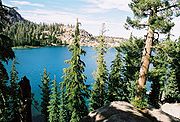
Carbohydrate
A carbohydrate is an organic compound with the empirical formula ; that is, consists only of carbon, hydrogen, and oxygen, with a hydrogen:oxygen atom ratio of 2:1 . However, there are exceptions to this. One common example would be deoxyribose, a component of DNA, which has the empirical...
s underground during the winter and grow very fast during the short growing season. Shrubs tend to be prostrate and low to the ground. This morphology
Morphology (biology)
In biology, morphology is a branch of bioscience dealing with the study of the form and structure of organisms and their specific structural features....
is advantageous because temperatures near the ground tend to be slightly higher during the day, which helps to maximize photosynthesis, and plants are less exposed to wind close to the ground.
Unlike alpine ecosystems
Alpine tundra
Alpine tundra is a natural region that does not contain trees because it is at high altitude. Alpine tundra is distinguished from arctic tundra, because alpine soils are generally better drained than arctic soils...
, which do not have long enough growing seasons to support annuals or ephemeral perennials, subalpine ecosystems do often support these growth forms, particularly on south-facing slopes. Annuals that grow in subalpine
Subalpine
The subalpine zone is the biotic zone immediately below tree line around the world. Species that occur in this zone depend on the location of the zone on the Earth, for example, Snow Gum in Australia, or Subalpine Larch, Mountain Hemlock and Subalpine Fir in western North America.Trees in the...
are usually quite small and grow very fast.
The most ubiquitous adaptation of subalpine plants is the ability to perform metabolic activities at extremely low temperatures. Again, without this trait, the growing season would not be long enough to support sustained life. A side effect of this trait is slow growth, even when conditions are good, which may be a major factor in setting the lower limits of subalpine zones. Because subalpine tree species have such slow growth, they are out-competed at lower elevations by trees capable of more rigorous growth, such as red fir. Slow growth, however, may be an adaptation in and of itself in extremely harsh environments as it leads to very long-lived individuals. Many of the tree species in Sierran subalpine are capable of living over 500 years. Whitebark pine has been found to live as long as 800 years, and foxtail pine, which is closely related to bristlecone pine
Bristlecone pine
The bristlecone pines are a small group of pine trees that are thought to reach an age far greater than that of any other single living organism known, up to nearly 5,000 years....
(Pinus longaevis) has been estimated to live 2500-3000 years. Seedling establishment in the harsh subalpine environment is difficult, so evolution has instead favored long-lived individuals that are reproductively active for tens or hundreds of years.
Species interactions
The harsh conditions present in the subalpine zone are sufficient to keep competitive interactions at a minimal level. Species interactions theory predicts that competition should be low in stressful environments and that positive, mutualistic interactions should be favored (e.g. ) In fact, lichens, which are mutualisms between fungi and algaeAlgae
Algae are a large and diverse group of simple, typically autotrophic organisms, ranging from unicellular to multicellular forms, such as the giant kelps that grow to 65 meters in length. They are photosynthetic like plants, and "simple" because their tissues are not organized into the many...
or cyanobacteria, are common in subalpine and alpine ecosystems. The clumpy nature of subalpine vegetation is also in part a manifestation of a positive interaction, whereby individuals increase their fitness by having neighbors that reduce the effects of high wind and cold temperatures.
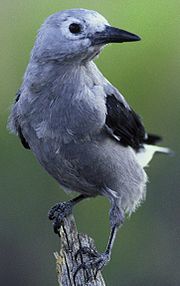
Clark's Nutcracker
Clark's Nutcracker , sometimes referred to as Clark's Crow or Woodpecker Crow, is a passerine bird in the family Corvidae. It is slightly smaller than its Eurasian relative the Spotted Nutcracker . It is ashy-grey all over except for the black-and-white wings and central tail feathers...
and two pines of the subalpine zone. Most pine species are wind-dispersed and their seeds are flat and winged. However, whitebark pine and limber pine both have non-winged, succulent seeds that have probably co-evolved with Clark’s nutcrackers. These birds, which use the seeds as a staple food source, cache seeds in the soil and in cracks of rocks. Like most caching species, the nutcrackers store more than they can ever find and eat, so many of the seeds can germinate when conditions are favorable. In the subalpine, this type of seed dispersal may be particularly advantageous because seeds find themselves immediately protected from high winds and low temperatures, and are therefore more likely to succeed during germination.
Climate change
Because the Sierran subalpine is situated in such harsh conditions, i.e. nearly at the limit of tree growth, the ecosystem is particularly sensitive to changes in climate. The long-lived nature of subalpine species plus their relative isolation from civilization make subalpine ecosystems a particularly good study system to examine climate change.The precise elevation of tree line within a given subalpine region has likely fluctuated up- and downslope throughout the history of the Sierra. However, some climatic changes occurring currently in subalpine appear to be unprecedented. Peterson et al. concluded that basal area
Basal area
Basal area is the term used in forest management that defines the cross-sectional area of a tree at DBH, inside the bark.In most countries, this is usually a measurement taken at a specimen's breast height above the ground and includes the entire diameter of every tree, including the bark...
increment (i.e. growth) increased for all age classes of whitebark pine and lodgepole pine over a 30-year period beginning around 1960. Millar et al. observed increased growth in whitebark pine and accelerated encroachment into snowfields by whitebark pine and western white pine during the 20th century, particularly since 1980. Bunn et al. showed that recent growth rates of subalpine conifers are greater than rates from any other period during the past 1000 years.
Specifically how subalpine ecosystems will respond to warming is yet to be determined. One logical (albeit largely untested) prediction is that plant communities will retreat upslope. If this prediction becomes a reality, it would likely mean the loss of a significant proportion of the subalpine zone that exists today. Since subalpine is the highest zone on many mountain peaks, the migration of subalpine to higher elevations will instead result in a reduction of the zone; in a manner of speaking, species will be pushed off the mountain. In a report sponsored by the California Energy Commission
California Energy Commission
The California Energy Commission is California’s primary energy policy and planning agency. Created in 1974 and headquartered in Sacramento, the Commission has responsibility for activities that include forecasting future energy needs, promoting energy efficiency through appliance and building...
and the California Environmental Protection Agency
California Environmental Protection Agency
The California Environmental Protection Agency is a state cabinet-level agency within the government of California. Cal/EPA is composed of six departments, boards and offices responsible for environmental research, regulating and administering the state's environmental protection programs, and...
, researchers simulated the effects of three different warming scenarios on different vegetation types in California over a period of 80-100 years. They concluded that alpine and subalpine vegetation would be reduced by approximately 50-80% of its current total cover.
Pollution
Few studies have addressed pollution in subalpine in the Sierra Nevada, although tree species present there may ultimately prove sensitive to certain atmospheric pollutants. One study from subalpine in the European Alps showed increased levels of atmospheric deposition of nitrogen at some locations. Jeffrey and ponderosa pine are susceptible to ozone pollution in the Sierra Nevada, but mostly at lower elevations. However, another study from the European AlpsAlps
The Alps is one of the great mountain range systems of Europe, stretching from Austria and Slovenia in the east through Italy, Switzerland, Liechtenstein and Germany to France in the west....
demonstrated the sensitivity of a native subalpine conifer to ozone pollution
Other environmental issues
The isolation and restricted use of subalpine systems keep them relatively free of recreational impacts. The harsh climate also makes these systems robust against biological invasion and disease. Most exotic plants in California are currently restricted to low elevations, although some invasives may have the potential to reach subalpine. If climate change does indeed warm regions where subalpine occurs, conditions there may become more conducive to threats such as invasive speciesInvasive species
"Invasive species", or invasive exotics, is a nomenclature term and categorization phrase used for flora and fauna, and for specific restoration-preservation processes in native habitats, with several definitions....
and disease.
See also
- Ecology of the Sierra Nevada
- Index: Fauna of the Sierra Nevada (U.S.)

